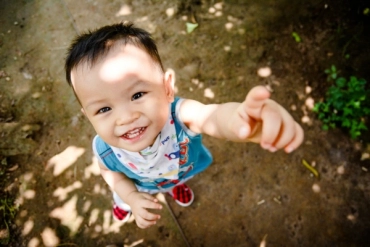Hey, guess what? It’s Autism Awareness Month! In lieu of that, we’re super excited to share with you ONE’s Expert Guide to 5 Early Signs of Autism.
There can be a lot of misinformation about autism in the internet. Remember the myths that our founder debunked in this interview? So we’re here to give you this no-nonsense, 100% fact-checked article on the early signs of autism.
We’ve compiled this guide from a whole lot of professional, credible sources. It’s by no means an exhaustive list. But, it does a pretty good job of summarising the basic signs of autism that could show up in a child.
Curious to learn more? Fantastic! Stick around with us to find out!

Restricted, Repetitive Behaviours Or Interests Could Be An Early Sign of Autism
Restricted Behaviours
Repetitive behaviours can include certain physical gestures, such as hand flapping, spinning or rocking one’s body. These behaviours are known as stimming, which help children with autism process sensory stimulation.
As mentioned in this article, people with autism view the world a little differently from neurotypical people. They may be extremely sensitive to certain sights, sounds and smells – or not sensitive to other sensations, such as temperature.
Stimming – repetitive behaviours and motions – helps people with autism process their surroundings. It keeps them grounded when they’re over- or under-stimulated.

Stims need not only be tactile stims (involving touch, such as rubbing or scratching one’s skin). They can also include vocal stims, like humming, or auditory stims, like snapping one’s fingers.
For example, a child with autism may shake their fingers in front of their eyes to make it look like lights are flickering. Alternatively, they may feel overwhelmed by certain textures of clothing, or the feeling of tags at the back of their shirts, and may cope by scratching their skin.
This article by WebMD is particularly helpful in understanding more about stimming in autism!
Restricted Interests
Children with autism may have narrow, intense interests that they can fixate on for unusually long periods of time.
These interests could be in letters or numbers, but this isn’t necessarily always the case. Often, the interests could focus on a specific cartoon character or obscure topic: Dinosaurs, for example. A child who hyperfixates on dinosaurs could give you the full scientific name of a type of dinosaur, its diet, and the time period it existed in.
But, this doesn’t mean that they will be as capable in another topic, such as mathematics or languages.

Likewise, an autistic child with hyperlexia may show rather exceptional linguistic skill. They may be able to decode and read words before the expected age. However, they may not understand the meaning of the words they are saying.
‘Restricted interests’ doesn’t necessarily correspond to low IQ, or extremely high IQ, either. Savant syndrome, where the individual with autism displays outstanding skill in a certain field, is in fact quite rare. Only about 10% of people with autism may have it.
All this is to say, autism is a spectrum. Restricted interests are very intense, but it is no indicator of the child’s intelligence or capability as a person.
Delayed Social Communication And Interaction Skills
Another early sign of autism could be a struggle in infants to distinguish faces of strangers from the faces of their caregivers. They may also avoid eye contact, make limited use of gestures, or not respond to their name being called. All of the above are unusual for developing babies without autism.
Delayed Developmental Milestones Could Be An Early Sign of Autism
For example, toddlers with autism may be less likely to point out the things they want. It would be expected for a child to point at a glass of juice in order to communicate ‘I want that.’

An early sign of autism could be the child instead holding their caregiver’s hand as a tool to communicate that they would like the glass of juice. This is known as hand-leading.
There’s actually a list of developmental milestones that children should reach by a certain age. Some of the social and emotional milestones by 7 months of age, for example, include enjoying social play and responding to other people’s expressions of emotions.
Types of Play Children With Autism May Engage In
However, a child with autism may instead prefer to play alone. They may be less inclined to share toys – though, it should be noted that this is not because they are ‘cold’ or ‘selfish’.
Like any other child, autistic children also enjoy making friends and forming connections. Their way of doing so may just be a little different from a neurotypical child.
For instance, children with autism may engage in parallel play. This is where they play separately from others, but close enough to still be able to watch and imitate their peers’ play. For example, a child with autism lining up blocks by size and colour, while nearby (in the same room) his friend builds a tower out of more blocks.

Collaborative play, which involves turn-taking and sharing, can still be taught to children with autism. However, this may not come entirely naturally to them and they may still find parallel play less stressful and more enjoyable. In that case, their time and space should of course still be respected.
For more types of play and the social-communication challenges of children with autism, this article by Healis Autism is particularly insightful.
Lack of Joint Attention Could Be An Early Sign of Autism
In layman terms, joint attention refers to a child focusing on the same thing that the adult is focusing on. This means that if a caregiver points at, let’s say, a bird – and says, “Look at that bird!”, the child will similarly direct their attention towards said bird.
This is important because joint attention is the earliest and simplest way for a child to discover the world around them.

By looking at the bird, they are able to associate the word ‘bird’ with the winged thing flying in the sky. On a larger scale, joint attention can help children to build their vocabulary, and identify and name objects. This is definitely important for their learning – both academically, and in life.
To be clear, a child with autism is still capable of joint attention. It just may not come to them as easily as it would for a child without autism.
This skill of joint attention partly falls under the abovementioned social communication and interaction skills. On the most basic level, a lack of joint attention means that an autistic child may seem to ignore their parents at times.
For example, it’s quite normal for a neurotypical child to be playing with a toy – a wooden top, maybe – and then suddenly look up at their parents. They may point at the top with their index finger and grin.
However, a child with autism may instead keep playing with the top without any visible acknowledgement of their parents’ presence.
Again, joint attention can be taught. A lack of it in early childhood does not mean that the child will grow up to be less intelligent than their peers. Nor does it mean that the child is unable to pay attention at all.
Extreme Sensory Sensitivities

Another early sign of autism is that children can be particularly sensitive to their environments. They could be overwhelmed by certain lights, temperatures and textures more than the average child.
For example, touching a hot stove may not feel painful to them, but tags on their clothes could irritate them to the point of tears. As such, children with autism may develop certain routines to help them cope with the overwhelming sensory inputs.
They may refuse to eat foods with certain textures, like mushy bananas, for example, but be quite content with eating leafy vegetables such as spinach. Alternatively, they may prefer wearing cotton shirts to nylon shirts.
All of the above are not indicators of the child being ‘picky’ or ‘fussy’ – certain sensory inputs are simply that unbearable for children (and adults, as well) with autism. Forcing a neurotypical child to eat the banana with their lunch may result in a bout of pouting. However, a child with autism may have a full-blown meltdown and refuse to eat at all.

This is through no fault of the child, but rather it’s just how their brain is structured: They’re more sensitive to such textures than the average child.
Occasionally, these extreme sensory sensitivities can result in very rigid routines throughout the day. For example, a child with autism may insist on wearing the same clothes every day, or eating the same food every meal.
In that case, parents should work out a compromise with their child, rather than force them to change their routine entirely. Doing so will cause great emotional and even physical distress.
For more information, this article is also particularly useful in guiding parents how to create a sensory-friendly haven in their home for children with autism.
Difficulty With Emotional Regulation
Difficulty with emotional regulation is also an early sign of autism. In the most basic terms, emotional regulation means that a person can experience an emotion, acknowledge it, and express it in a way that is appropriate to the situation at hand.
This can be done both consciously and unconsciously. For example, if a person cuts in front of the queue we might feel annoyed. Consciously, we might tell ourselves to calm down and reason that they might be in a rush. Or, we may choose to temper our tone and politely ask the person to go to the back of the queue.

However, emotional regulation may be more challenging for people with autism. This could be due to a variety of factors, including a difficulty in reading social and emotional cues (as discussed in the delayed social communication and interaction skills above). Also, the abovementioned extreme sensory sensitivity – it’s hard to stay calm when the environment feels overwhelming.
Hence, what could be a small annoyance for children without autism may affect a child with autism much more. For example, a meal served later than usual could lead to a child with autism having a full-blown meltdown.
This is not to say that emotional dysregulation is a permanent state for children, or even adults. It can definitely be taught, just that children with autism may initially find it more difficult than those without.
Some examples of such therapies that could help include cognitive behavioural therapy, which corrects and reframes negative thought patterns. To be clear, the goal of teaching emotional regulation is not to suppress the ‘bad feelings’ such as anger and sadness.

Rather, it’s to teach the child how to process, acknowledge and express it in a healthy way that is respectful to both themselves and others.
Final Thoughts
There we have it – 5 early signs of autism that a parent could look out for in their child. While the above sources are compiled from various credible articles and research papers, the list is by no means exhaustive.

Should you believe that your child might have autism, it’s always best that you get them checked out by a professional, rather than self-diagnose it. This is because for more severe cases of autism, specific early intervention programmes may be needed to help your child grow and thrive.
These will require professional help by experts, since a layperson may not have the most comprehensive knowledge about how to tailor such programmes. Doing so could in fact cause the child more harm than good.
In any case, ONE Intervention’s always got your back for this – you’re welcome to book a consultation with our professional Child Psychologist Grace Teo for a diagnosis. Contact us here 🗣️, or if you’ve any other experiences or questions that you’d like to share, drop us a comment below 💬
